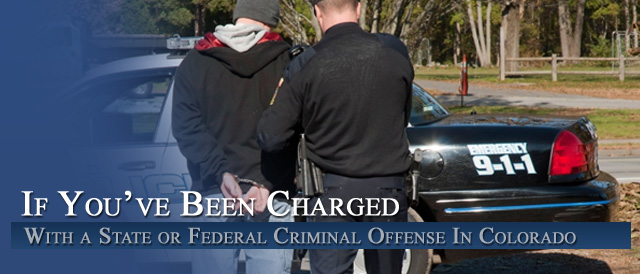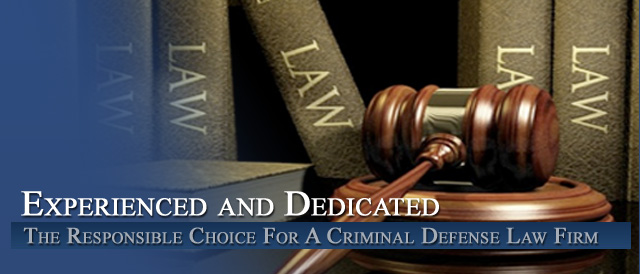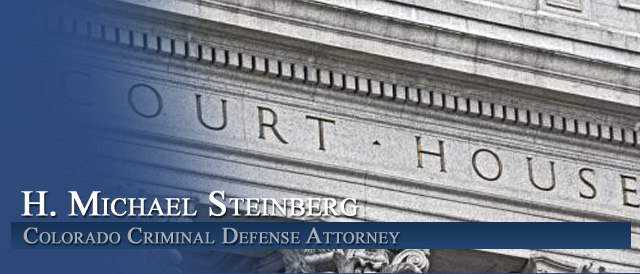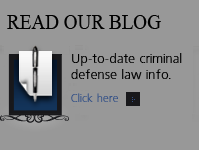




Federal Detention Hearings – Release or Detention Pending Judicial Proceedings Under 18 U.S.C. §§ 3141-3156
Federal Detention Hearings Law and Issues Compiled by Colorado Federal Criminal Defense Lawyer – H. Michael Steinberg
The very first opportunity to defend those charged with serious federal crimes is at the preliminary and the detention hearing. This pair of hearings gives lawyers their first opportunity to have an adversarial hearing and begin to see the government’s case. However the preliminary and detention hearing is often the government’s first opportunity to target the client, by requesting detention rather than allowing the setting of a reasonable bail bond.
A federal criminal case is different – depending on the crime charged it may be better or worse than state court – but it is different. Some Colorado criminal defense attorneys do not handle federal matters because the matters tend to be complex, and the penalties are extremely harsh and unforgiving. Certain special skills, experience and knowledge are required, and it is important that your Colorado Criminal Defense Lawyer be well-versed in the Federal Criminal Code, the Federal Rules of Criminal Procedure, and the Federal Sentencing Guidelines.
An experienced Colorado federal criminal defense lawyer will help you design a plan to avoid the mistakes that can be made if your case is not defended properly. A great federal criminal defense lawyer will keep you informed throughout the process.
Understanding The Purpose of the Bail Reform Act
The primary purpose was to de-emphasize use of money bonds and to provide flexible alternatives to judges setting high bail. The Act further intended to eliminate practice of detaining dangerous defendants by setting of high bail. The Act specifically prohibits using high financial conditions to detain defendants. Importantly the Act (18 U.S.C. § 3142(b)) expressly provides that a defendant shall be released on a recognizance bond – unless:
1. the defendant represents a serious flight risk;
or
2. the defendant presents a danger to the community.
The General Provisions Regarding Bail and Detention in Criminal Cases
The Eighth Amendment to the United States Constitution provides that “[e]xcessive bail shall not be required . . .” U.S. Const. Amend. VIII. The United States Supreme Court has interpreted this amendment to prohibit the imposition of excessive bail without creating a right to bail in criminal cases.
But the eighth amendment does not grant absolute right to bail. The subject of bail and detention also implicates the Fourteenth Amendment’s Due Process Clause, and requires that laws imposing pretrial detention “serve a compelling governmental interest”,
In federal criminal proceedings, release and detention determinations are governed by the Bail Reform Act of 1984. 18 U.S.C. §§ 3141-3156 (1990). These sections contain specific guidelines that “judicial officers” must follow in considering whether a defendant should be detained or released pending federal criminal proceedings.
Title 18, United States Code, Section 3141(a) gives “judicial officers” authority to make determinations regarding bail in all stages of a criminal case, up to and including the trial stage.
The term “judicial officers” is defined in Title 18, United States Code, Section 3156, along with other terms relevant to the matter of bail in criminal cases. Once a defendant has been convicted of the federal charges, Title 18, United States Code, Section 3141(b) vests authority with district judges and the appellate courts to make bail determinations pending the imposition or execution of sentence, or pending appeal of the same.
The Role Of Pretrial Services In Setting Bond and Bond Conditions
What are “pretrial service providers”?
Pretrial service providers have several functions:
Gather Information
Pretrial service providers gather information about a defendant to assess a defendant’s risk of endangering the community or failing to appear in court. This information includes: a defendant’s residence, employment, and community ties; a defendant’s criminal history; and whether defendant is on probation, parole, or pretrial release.
Assess Risks
. After gathering this information, pretrial service providers synthesize the information in order to assess the defendant’s risk. The most successful pretrial services programs use an evidence-based risk assessment tool to make these assessments. The service providers then present this information and assessment to the court during the defendant’s initial appearance. Judges use this information to help determine an appropriate release option that assures the community’s safety and the defendant’s appearance.
Provide Supervision
Pretrial service programs supervise defendants who have been released under specified conditions. These conditions include requiring a defendant to report in regularly, undergo drug or alcohol testing or treatment, or be monitored electronically. Pretrial service programs report to the court on a defendant’s compliance with pretrial conditions.
Title 18, United States Code, Sections 3152 through 3154 pertain to the administration and the supervision authority of pretrial services officers in the federal criminal system. Section 3154 specifically empowers pretrial services officers with the authority to collect information from defendants and other sources relative to the matter of bail.
Pretrial services officers are authorized to make recommendations as to whether a defendant should be detained or released, including specific recommendations regarding conditions of release. 18 U.S.C. § 3154(1). Pretrial services officers are also authorized to establish facilities for and conduct the supervision of defendants released under the provisions of Section 3142.
The Pre-Trial Services Report
The pretrial service officer’s report is often a good source of information relating to the background of a defendant. Attorneys on the case are permitted to view a copy of the pretrial report (usually marked “Attorney’s Copy”). The report relates to a defendant’s community contacts, pager and telephone numbers, bank information, asset information, criminal history, etc. A review of the pretrial report is essential to make an accurate statement regarding either side’s position on the matter of bond.
The Categories Of Federal Pretrial Release and Detention
Title 18, United States Code, Section 3142 defines the categories of “release and detention” a defendant may be subject to and contains the rules under which the court and parties must proceed relating to bail matters.
Section 3142(a) states “that upon the appearance before a judicial officer of a person charged with an offense, the judicial officer shall make a determination regarding bail status of the defendant, and shall enter an order designating a defendant’s custodial status” under one of four categories:
- released on personal recognizance or upon execution of an unsecured appearance bond (following the provisions of Section 3142(b));
- released on a condition or combination of conditions as defined by Section 3142(c);
- temporarily detained to permit revocation of conditional release, deportation, or exclusion under Section 3142(d); or
- detained pursuant to the provisions of Section 3142(e).
- Release on Personal Recognizance/Unsecured Appearance Bond
Title 18, United States Code, Section 3142(b) requires a judicial officer to order the pretrial release of a defendant on “personal recognizance” or upon the defendant’s execution of an “unsecured appearance bond” in an amount specified by the court.
A Section 3142(b) release order must be conditioned on a defendant’s agreement to “not commit a Federal, State, or local crime during the period of release.” If, however, the judicial officer determines that the release of a defendant on “personal recognizance” or “unsecured appearance bond” would not “reasonably assure” the defendant’s appearance at court proceedings, or will “endanger the safety of any other person or the community”, then there is no obligation to order release. 18 U.S.C. §§ 3142(b) and 3142(c).
In this event, the judicial officer must follow the provisions of Title 18, United States Code, Section 3142 ( c ). ( see below )
Release On Conditions
Once a judicial officer has made the determination that a defendant does not qualify for release under Section 3142(b), then the judicial officer must follow Section 3142(c). When structuring the release of a defendant under Section 3142(c), the judicial officer must order that the defendant “not commit a Federal, State, or Local crime during the period of release..
The judicial officer must impose the least restrictive condition or combination of conditions necessary to “reasonably assure” the defendant’s appearance as required and to “reasonably assure” the safety of any person and the community 18 U.S.C. § 3142(c)(1)(B)
An illustrative list of conditions is set forth in § 3142(c)(1)(B)(i through xiv) which gives the judicial officer authority to impose conditions not specifically enumerated so long as the same serve the purposes set out in § 3142(c)(1)(B). Section 3142 speaks only of conditions that will “reasonably” assure appearance, not guarantee it”.
A judicial officer is not permitted to impose any financial conditions of release which result in the pretrial detention of a defendant. 18 U.S.C. § 3142(c)(2).
The conditions of release imposed on a defendant under a Section 3142(c) order may be amended at any time to impose additional or different conditions of release. 18 U.S.C. § 3142(c)(3).
Factors Judicial Officer Must Take Into Consideration Regarding A Defendant’s Eligibility For Release
When making a determination regarding the eligibility of a defendant for pretrial release (whether personal recognizance , unsecured appearance bond, or release on conditions), the judicial officer must consider the factors listed in Section 3142(g), including:
- the nature and circumstances of the offense (in particular whether it is an offense which is violent or nonviolent in nature, or involves narcotics);
- the weight of the evidence against the person;
- the history and characteristics of the person
- character — including physical and mental condition), family ties, employment, financial resources, length of time in the community, community ties, past conduct history relating to drug or alcohol abuse, criminal history, record of court appearances;
- whether, at the time of the current offense or arrest, the person was on probation, on parole, or on other release pending trial, sentencing, appeal, or completion of sentence for an offense under Federal, State, or local law;
and
- the nature and seriousness of the danger to any person or to the community that would be posed by the person’s release.
Property Bonds As Collateral For Bonding Out 18 U.S.C. § 3142(g)
In addition to considering evidence of the factors set forth above, the court may upon its own motion, or upon the motion of the government attorney, conduct an inquiry into the source of any property to be designated for potential forfeiture or offered as collateral to secure any bond. 18 U.S.C. § 3142(g)(4). If the court determines that any such collateral or property, because of its source, will not reasonably assure the appearance of the defendant as required, the designation or use of the collateral or property as security for a bond shall be refused. 18 U.S.C. § 3142(g)(4).
Considerations Regarding Temporary Detention Orders
Title 18, United States Code, Section 3142(d) requires a judicial officer to enter an order of temporary detention in cases where a factual determination is made that:
- the defendant:
- is, and was at the time the offense was committed, on
- release pending trial for a felony under Federal, State, or local law;
- release pending imposition or execution of sentence, appeal of sentence or conviction, or completion of sentence, for any offense under Federal, State, or local law; or
- probation or parole for any offense under Federal, State, or local law;
OR
- is not a citizen of the United States or lawfully admitted for permanent residence, as defined in section 101(a)(20) of the Immigration and Nationality Act (8 U.S.C. 1101(a)(2); AND
- the defendant may flee or pose a danger to any other person or the community.
The formula for calculating the 10 day temporary detention period is set forth in Section 3142(d). At the time the 10 day order is entered, the judicial officer must direct the attorney for the government to notify the appropriate “authorities” of the defendant’s status. In the event that the “notified authority” declines to take the defendant into custody, then the judicial officer must make an independent determination regarding bail under the provisions of Sections 3142(b), 3142(c), and 3142(e)(if the government moves for detention).
Pretrial Motions for Detention
The Bail Reform Act requires the pretrial detention of a defendant only if a judicial officer determines that no conditions or combination of conditions exist which will “reasonably assure the appearance of the person” and “the safety of any other person and the community.”
Cases Which Qualify For Detention Hearings
Section 3142(f) defines specific situations under which a judicial officer may hold a detention hearing.
Upon the motion of the government attorney, in a case that involves:
- a crime of violence;
- an offense with a maximum sentence of life imprisonment or death;
- an offense for which the maximum term of imprisonment is 10 or more years as prescribed by the Controlled Substances Act; or
- any felony if the person has been convicted of two or more offenses described in paragraphs (a) through (c) or comparable state offenses.
Upon the motion of the government attorney or on the court’s own motion, in a case that involves:
- a serious risk of flight; or
- a serious risk that the defendant will obstruct justice or threaten a witness.
Limits On The Government’s Authority To Detain
18 U.S.C. § 3142(f). Section 3142(f) “does not authorize a detention hearing in the absence of one of the six situations set forth above.” The government may not request a detention hearing only on the allegations of danger to the community or another person.
The “government is required to demonstrate that there are grounds for a hearing under the specific provisions of either 3142(f)(1) or (f)(2).”
When there exists one or more grounds for holding a hearing under those provisions, the government may proceed on the theory of risk of flight and/or danger to the community or any other person.”
Section 3142(f) may fairly be interpreted as authorizing pretrial detention “only upon proof of a likelihood of flight, a threatened obstruction of justice or a danger of recidivism in one or more of the crimes actually specified by the bail statute.”
Alleged Danger To The Community
When the court has determined that a detention hearing is warranted, it may consider evidence relating to a defendant’s danger to the community. Detention considerations are then guided by the factors set forth in 18 U.S.C. § 3142(g), and the specific consideration of “the nature and seriousness of the danger to any person or the community that would be posed by the person’s release.”18 U.S.C. § 3142(g)(4).
The government must first prove one or more of the grounds listed in 3142(f)(1) or (2) as a prerequisite to the court considering the factor of danger to the community whether there exist appropriate conditions of release in the case.
For example – certain facts support such a determination under case law – There is danger inherent to the community in the unlawful possession of firearms, both a rifle and a pipe bomb. This is particularly true where the possessor has a lengthy criminal history, has not been deterred from the commission of crime by prior convictions and appears to be involved in ongoing drug offenses.
The Timing Of Detention Hearing
Title 18, United States Code, Section 3142(f)(2) contains specific guidelines regarding the timing of detention hearings. The hearing is supposed to take place immediately upon the defendant’s first appearance before the judicial officer. However, a defendant may lack representation at this initial appearance or there may not be enough information to conduct an informed decision.
Under these circumstances the detention hearing is not likely to go forward unless the court has made other arrangements for the defendant to be represented by counsel. Section 3142(f)(2) also permits a 3 day delay of the detention hearing upon the motion of the government attorney.
BUT – Defense Based Requested Continuances – 5 Days
A defendant may request a continuance of up to 5 days under this section, for good cause shown. Between the time the detention motion is filed and the actual detention hearing (up through the court’s ruling on the motion for detention), the defendant will remain in the custody of the United States Marshal’s Office. 18 U.S.C. § 3142(f)(2).
Reopening The Findings Of The Initial Detention Hearing For Modifications
A hearing may be reopened before or after the court’s ruling on a detention motion, at any time before trial if the judicial officer makes a factual finding that information exists that was not previously known ( new evidence) at the time of the hearing and that the information is material on the issue of whether there are conditions of release that will reasonably assure the appearance of the defendant and the safety of any other person and the community.
What Is New Evidence:
A Court may reopen hearing if newly discovered evidence comes to Court’s attention. 18 U.S.C. § 3142(f). – The new evidence, if proffered by Government, must not have been available at first hearing. And the new evidence must be exceptional to justify new detention hearing
Detention Hearings May Proceed By Way of Proffer – Rules of Evidence Do Not Apply
Detention hearings are an informal proceeding, and the evidence presented is not governed by the Federal Rules of Evidence. The government may proceed in a detention hearing by way of proffer. The reason for permitting detention hearings to proceed by way of proffer is that such hearings are “neither a discovery device for the defense nor a trial on the merits.”
“The process that is due is only that which is required by and proportionate to the purpose of the proceeding.” Case law supports the proposition that the purpose of pretrial detention hearing is not to “rehash . probable cause” but to provide opportunity for detainee to show no risk of flight or danger to community. The government is not required to produce its witnesses against a defendant because that – ( the case law states ) would complicate the hearing to a degree out of proportion to the liberty interest at stake – viz. the interest in remaining free until trial, for what is by statute a period of limited duration.
Application of the Rebuttable Presumption
Title 18, United States Code, Section 3142(e) contains three categories of criminal offenses that give rise to a rebuttable presumption that “no condition or combination of conditions” will:
(1) “reasonably assure” the safety of any other person and the community if the defendant is released;
or
(2) “reasonably assure” the appearance of the defendant as required and “reasonably assure” the safety of any other person and the community if the defendant is released.
These categories are: (A judicial officer finds that:)
- the person has been convicted of a Federal offense that is described in subsection (f)(1) of this section, or of a State or local offense that would have been an offense described in subsection (f)(1) of this section if a circumstance giving rise to Federal jurisdiction had existed;
- the offense described in paragraph one of this subsection was committed while the person was on release pending trial for a Federal, State, or local offense; and
- a period of not more than five years has elapsed since the date of conviction, or the release of the person from imprisonment, for the offense described in paragraph (1) of this subsection, whichever is later. 18 U.S.C. § 3142(e)(1)-(3).
- A judicial officer finds that there is probable cause to believe that the person committed an offense for which a maximum term of imprisonment of 10 years or more is prescribed.
- A judicial officer finds that there is probable cause to believe that the person committed an offense under 18 U.S.C. § 924(c).18 U.S.C. § 3142(e).
The rebuttable presumption relating only to the safety of any other person and the community pertains to those cases meeting the criteria of Section 3142(e)(1)-(3). ALL of these conditions must be met for the proper application of the rebuttable presumption of “danger to the community.”
The Grounds for The Request – A Closer Look at 18 U.S.C. § 3142(f).
1. Government believes person poses a serious flight risk.
2. Government believes defendant will threaten witnesses, etc.
3. Person is charged with: a crime of “violence,” which is defined by 18 U.S.C. § 3156(a)(4) as:
(A) an offense that has as an element of the use, attempted use, or threatened use of physical force against the person or property of another;
(B) any other offense that is a felony and that, by its nature, involves a substantial risk that physical force against the person or property of another may be used in the course of committing the offense;
or
(C) any felony charged under sexual abuse or abuse of children statutes.
4. any terrorist offense listed in 18 U.S.C. § 2332b(g)(5)(B) with penalty over 10 years
5. an offense involving death penalty or life imprisonment;
6. a drug offense involving penalty of ten years or more;
7. any felony after defendant has committed two or more crimes of violence or drug offenses; or
8. any crime which is not a crime of violence that involves a minor victim, possession of a firearm or destructive device, or failure to register as a sex offender.
Drug Offenses – Greater Than 10- Years
The rebuttable presumption relating to both “risk of flight” and “danger to the community” pertains to those cases where the judicial officer finds there is probable cause to believe that the defendant committed:
(1) a drug offense (as defined under Title 21) when the maximum term of imprisonment is 10 years or more;
or
(2) an offense under Title 18, United States Code, Section 924(c). 18 U.S.C. § 3142(e).
The indictment alone is sufficient to raise the rebuttable presumption that no condition (or combination of conditions) will ensure the defendant’s reappearance for trial and that no conditions of release will ensure the safety of the community,
The Burden of Proof At Detention Hearing
In a pretrial detention hearing, the government’s burden is to establish by clear and convincing evidence that no conditions of release will reasonably assure the safety of the community.
The issue in such a hearing is whether releasing a defendant would pose a danger to the community that would not exist were the defendant detained.
The standard is different when the issue is whether any conditions of release will reasonably assure the defendant’s attendance at trial (risk of flight); the government need only prove that there are no such conditions by a “preponderance of the evidence.”
It is not necessary that the government prove both flight risk and danger to the community to warrant detention.
The Requirements For The Contents Of Release and Detention Orders
Title 18, United States Code, Section 3142(h) lists the requirements for the contents of a “release order.” Title 18, United States Code, Section 3142(g) lists the requirements for the contents of a “detention order,” including the requirement of “written findings of fact and a written statement of the reasons for detention.”
The Defendant’s Bail Application Following Pretrial Detention
When a defendant moves for release on bail following pretrial detention, the court must consider three factors:
(1) the length of the pretrial detention;
(2) the extent to which the prosecution is responsible for the delay of the trial;
and
(3) the strength of the evidence upon which the pretrial detention was based.”
Regarding the length of pretrial detention, there is no doubt that the longer the pretrial detention the more likely the denial of due process. Typically, this factor weighs in favor of the moving defendant.
Considerations Regarding Breach of A Condition of Bond
Title 18, United States Code, Sections 3146 through 3148 describe the penalties a defendant may be subject to for:
- (1) failure to appear at any proceeding as required (Section 3146);
- (2) committing an offense while on pretrial release (Section 3147);
and
- (3) violating any condition of pretrial release (which includes the sanction of bond revocation) (Section 3148).
Arrest Of The Bond Violator
Title 18, United States Code, Section 3149 empowers a surety with arrest authority over offenders, and requires that the surety promptly deliver the offender to the custody of the United States Marshal for proceedings under Section 3148.
Federal Rule of Criminal Procedure 46(e) provides that “[i]f there is a breach of condition of a bond, the district court shall declare a forfeiture of the bail.” F.R.Crim.P. 46(e). This language is broad, and reaches any condition of release.
Considerations Regarding A Defendant’s Appeal of Detention Order
When a defendant seeks review of a magistrate judge’s order of detention, the district court is bound to review the matter de novo, and undertake a complete review of the matter for the purpose of arriving at its own “independent conclusion.” 18 U.S.C. § 3145(a)-(c).
See also Rule 46 of the Federal Rules of Criminal Procedure
See the United States Attorney Manual on this topic.
Please call our law firm if you have questions about ..
Federal Detention Hearings
H. Michael Steinberg has been a Colorado criminal law specialist attorney for 40 years (as of 2012). For the First 13 years of his career, he was an Arapahoe – Douglas County District Attorney Senior prosecutor. In 1999 he formed his own law firm for the defense of Colorado criminal cases.
In addition to handling tens of thousands of cases in the trial courts of Colorado, he has written hundreds of articles regarding the practice of Colorado criminal law and frequently provides legal analysis on radio and television, appearing on the Fox News Channel, CNN and Various National and Local Newspapers and Radio Stations. Please call him at your convenience at 720-220-2277
If you have questions about Federal Detention Hearings in the Denver Colorado metropolitan area and throughout Colorado, attorney H. Michael Steinberg will be pleased to answer those questions and will provide quality legal representation to those charged in Colorado adult and juvenile criminal matters as regards Federal Detention Hearings.
Other Articles of Interest:
- Colorado Federal Criminal Law: The Arrest and Setting of Bail
- 024. COLORADO CRIMINAL CODE – GOVERNMENTAL OPERATIONS – ESCAPE – AND INTRODUCING CONTRABAND CRIMES
- Understanding House Arrest, Home Confinement or In Home Detention as a Jail Alternative in Colorado Criminal Sentencing Cases
- Colorado Criminal Juvenile Law- A Basic Introduction to Understanding How the Colorado Juvenile Justice System “Works”
- Colorado Juvenile Arrests – What A Colorado Juvenile Criminal Defense Lawyer Actually Does – or Should Do – When Your Child Has Been Arrested













